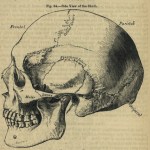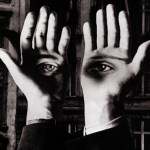
Anatomical engraving from Henry Gray's Anatomy, 1858.
A month or so ago, Abrams books reached out to mention that they were releasing a new title, Human Anatomy: A Visual History from the Renaissance to the Digital Age. I said, "don't I already have this book?" It turns out I did - I had the previous, hardback edition which I picked up for $25 or so on Amazon (a deal, I thought at the time). So I knew this book should really be subtitled "vintage eye candy from Vesalius to Schmiedel," because it's a bundle of rich images from anatomical atlases, interspersed with just enough curation to give…
"Reasoning was not designed to pursue the truth. Reasoning was designed by evolution to help us win arguments."
- Jonathan Haidt, "The New Science of Morality",
invoking the work of H. Mercier and D. Sperber.
(the whole talk is really interesting).
Oh, to be eight years old again, and oh-so-eager to suspend all disbelief. . . this video had me laughing in pure delight:
The baby T-Rex, which you can obviously tell is an actor (see the legs?) is touring Australian schools to promote the show "Walking with Dinosaurs." Don't get me wrong - the show looks as charming as a James Gurney musical - but I really love the expressions on the childrens' faces as they're alternately surprised, scared, and thrilled. I think I just saw four or five future paleontologists spring into being. . .
Via, like, everybody. It's dinoviral.
I've been remiss in not recommending my temporary Scienceblogs scibling "Art and Science Learning" to those of you who are, like me, interested in the sciart intersection. However, I have to say I am not 100% behind its latest (and quite popular post), by Robert Root-Bernstein. It starts,
Most people are at a loss to be able to identify any useful connections between arts and sciences. This ignorance is appalling.
Hmmm. Do you think that's really true, much less "appalling"?
I'm not so sure. I do think it's true that people tend to view arts and sciences as distinct disciplines, which is…
Calling all dataviz peeps: you know you want to meet Stephen Colbert. All you have to do is win DonorsChoose's version of the Netflix Prize.
It's a contest called "Hacking Education". DonorsChoose explains, "We've opened up [our] data, and invite you to make discoveries and build apps that improve education in America. Help to shape your school system's budget by revealing what teachers really need. Build the first mobile app for hyper-local education philanthropy. We've got a list of suggestions to help get you thinking."
Good luck!
Yesterday, bioephemera got its one millionth visit.*
Thanks so much to everyone who reads, shares, and enjoys my posts - you're why I keep blogging, in whatever spare time I can find. There's just too much interesting stuff out there to keep it to myself when I find it, and I've met far too many fascinating and brilliant people who defy categorization by doing this. . . you know who you are.
Rabelais was gloriously learned because learning amused him, and so far as I am concerned, that is learning's best justification. Not the only one, but the best. --Robertson Davies, The Rebel Angels…
Haute Macabre found artist Celina Saubidet on etsy, where she sells silver-plated bronze "osseous jewelry" from her shop Joyeria Osea. I think this skeletal hand is pretty over the top, but hey - sometimes you need a little drama. Check out her fingerbone rings for a more subtle anatomical statement.
Adam Winnik sent me this animation inspired by Carl Sagan's famous "pale blue dot" monologue. It's true to the serious implications of Sagan's words, yet wry and lighthearted (mostly). A lovely example of remix culture revitalizing a classic of biology.
Adam gives some background:
I've been enrolled in illustration at Sheridan College for the the last 4 years and this is my final thesis project. I have always thought of Carl Sagan's writings as "scientific poetry" since they lack the cold touch that science is often cursed for having. I think Sagan's words resonate more than ever, and will…
At the moment, a few blocks away, a few of my friends are attending a Science and Technology Studies (STS) conference at the Harvard Kennedy School. I have no idea what they're doing, although I'm sure it's very smart. I'm only here to tell you they have THE CREEPIEST POSTER I have ever seen for an academic conference:
I'm just saying, STS is definitely humanities, not science. (Now I have to run away before my boyfriend retaliates). When did you last attend a scientific conference with a vintage, artsy, creepy poster by the last surviving member of the Bauhaus? Nice work, Alex Wellerstein.…
While we're on the bioanimation topic, I recently heard from Jess at Nervous System, who sent me links to some animations of their new jewelry line, hyphae, "growing" in virtual space. Check it out:
Hyphae - growth of the Vessel Pendant from Nervous System on Vimeo.
They explain,
Hyphae is a collection of 3D printed artifacts constructed of rhizome-like networks. Inspired by the vein structures that carry fluids through organisms from the leaves of plants to our own circulatory systems, we created a simulation which uses physical growth principles to build sculptural, organic structures.…
Remember when I said more bio grad students should play with coding and modeling? Here's an example of what I mean. Laurence Frabotta directed me to this animation by phylogeneticist/bioinformatics programmer Liam Revell, an assistant professor at U Mass Boston, who used the statistical package 'R' to write a short code generating all possible bifurcating and multifurcating phylogenetic trees for a set of taxa. Apparently there are 2,752 for seven taxa (I have to take his word for it, my basic math skills have long since escaped me) and this animation runs through all of them. It's not…
Wait - did Peter Nowogrodski just shoehorn everything I love into one meandering, indulgent multimedia essay??*
Tolkien's Shire appears as a coherent ecosystem, cradled by productive fields and populated by abundant orchards, caches of edible mushroom, and even the fishable Bywater Pool, ornamented with an authentic churning mill. The land at Hobbiton is changing still: Jackson's crowning oak tree now sits in sun-scarred pieces behind a rotten wooden fence at the termination of Bagshot Row, a home for the welcome swallows that course through air above. In the pastures opposite Bag End, a…
Wow - my post about unhappy bio grad students is getting massive traffic. (Hi SlashDotters and StumbleUpon-ers!) Mike the Mad Biologist, my original inspiration, has responded here and here to all the buzz.
I pretty much said everything I wanted to say in the original post, and I don't pretend to have an explanation or cure for this problem. But I see that there's been some snarkiness on the intertubez (shocking!!!) while I was away watching the developments in the Myriad appeal. So I want to clarify two points.
First, let me emphasize that I'm not saying graduate students in other fields don…
The oral arguments in Monday's Myriad appeal are online here. (Scroll down and look for Association for Molecular [Pathology] v. PTO).
Tomorrow morning, a three-judge panel of the Court of Appeals for the Federal Circuit will hear arguments in the appeal of Association for Molecular Pathology v. U.S. Patent and Trademark Office - better known as the Myriad gene patent case.* It has the patent and genetic blogospheres in a bit of a tizzy, and the mainstream media is picking up on it too. See, for example, this Atlantic article by Andrew Cohen, this Nature.com editorial by my friend Shobita Parthasarathy, and even a "Spectator's Guide to the Myriad Oral Argument" by Genomics Law Report -- which has a dedicated icon and…
It's the very last installment of Zombiefest - one more book review, this time for one I heartily recommend!
Daniel Drezner, a professor of international politics at Tufts, prefaces his new book about zombies with an unexpected vignette - a visit to Graceland:
By the time my tour hit the Jungle Room, it was obvious that the thirty-odd people walking through Elvis Presley's mansion fell into two groups. The first contingent was thoroughly, utterly sincere in their devotion to all things Elvis. They were hardcore fans, and Graceland was their Mecca, their Jerusalem, and their Rome. . . the…
The myriad miseries of graduate school are reserved to no one discipline, but there may be something to the contention that biology graduate programs are particularly bad. Here's what Mike the Mad Biologist says, in response to Science Professor, and I think he's quite right:
The basic problem stems (so to speak) from too many biology Ph.D.s and not enough funding, leading to an immensely cutthroat environment--and one that is psychologically damaging to boot. . . .So why does this dysfunctional cultural paradigm exist? I think it has to do with two things: specialization and Ph.D. training…
Here's Alexis Madrigal on why the slow loris' newfound YouTube fame could be the worst possible thing for the little primates:
Talk about a buzzkill: watching a video of a cute animal on the Internet may -- in some small way -- lead to it being ripped from its mother, abused, and sold on the global market.
I know, I know: most of us can coo over small furry critters with extreme neoteny, while refraining from buying them on the black market. And it's not YouTube's fault that the loris is adorable. It's just truly sad that popularizing an endangered animal most people don't even realize exists…
Shambling, slowly disintegrating zombies aren't good for much - but maybe they're helpful for teaching neurobiology?
The Zombie Autopsies with Steven Schlozman, MD from GCP authors on Vimeo.
It is all about braaaaiiiiiinnns, after all. . . .
Read all about Zombie Autopsies here, or head to Amazon.
The week of Zombiefest continues, with the photography of Danielle Tunstall, who calls them "life and death working together hand in hand." "Fragile," above, is available as a print.
via Haute Macabre.





